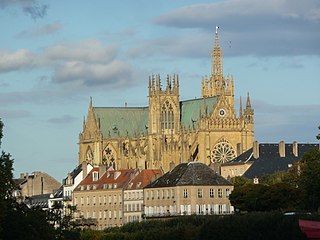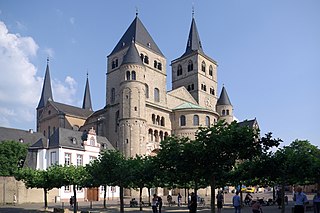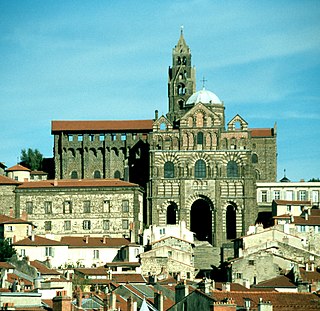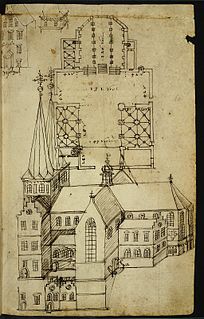
The Church of Saint Anne (Dutch: Sint-Annakerk) is a partly Romanesque, partly Gothic church in Aldeneik, Belgium. [1]

The Church of Saint Anne (Dutch: Sint-Annakerk) is a partly Romanesque, partly Gothic church in Aldeneik, Belgium. [1]
Originally, the church was part of Aldeneik Abbey, a Benedictine nunnery, founded by the holy sisters Harlindis and Relindis on their father Adelard's estate in Eike (Aldeneik). In the 10th century, emperor Otto I donated the monastery to the Prince-Bishopric of Liège in order to prevent local nobleman from seizing control of the property. Shortly afterwards the nunnery was replaced by a collegiate chapter of (male) canons, who in the 12th century built the Romanesque church which partly survives in the present building. Since the 16th century it has served as a Roman Catholic parish church. Originally dedicated to Saint Mary, later to Mary and Saint Peter, in the 18th century it was dedicated to Saint Anne.
The present church was partly built in the 12th century and consists of a 3-aisle basilica in Mosan style, without transepts. In the 13th or 14th century the choir was replaced in Gothic style. After the chapter moved to Maaseik in 1571, the church became too big for the small congregation that continued to use it. The aisles were probably demolished shortly afterwards. Part of the westwork was also demolished or destroyed. In the 19th century the westwork was rebuilt, although it was not clear what the original westwork had looked like. The side aisles were rebuilt in the same period.
The nave is the best preserved part of the original interior of the church, although the wooden ceiling was renewed in the 19th century. The primitive red and ochre murals in the nave date from the 13th century and are among the oldest in Belgium. The choir is lit by two rose windows and five lancet windows.

Romanesque architecture is an architectural style of medieval Europe characterized by semi-circular arches. There is no consensus for the beginning date of the Romanesque style, with proposals ranging from the 6th to the 11th century, this later date being the most commonly held. In the 12th century it developed into the Gothic style, marked by pointed arches. Examples of Romanesque architecture can be found across the continent, making it the first pan-European architectural style since Imperial Roman architecture. The Romanesque style in England and Sicily is traditionally referred to as Norman architecture.

Maaseik is a city and municipality in the Belgian province of Limburg. Both in size and in population, it is the 8th largest municipality in Limburg. The town is the seat of the administrative arrondissement of Maaseik (kieskanton). Internationally, Maaseik is known as the assumed birthplace of the famous Flemish painters Jan and Hubert van Eyck.

Laon Cathedral is a Roman Catholic church located in Laon, Aisne, Hauts-de-France, France. Built in the twelfth and thirteenth centuries, it is one of the most important and stylistically unified examples of early Gothic architecture. The church served as the cathedral of the Diocese of Laon until 1802, and has been recognized as a monument historique since 1840.

Auxerre Cathedral is a Roman Catholic church, dedicated to Saint Stephen, located in Auxerre, Burgundy, France. It was constructed between the 13th and 16th centuries, on the site of a Romanesque cathedral from the 11th century, whose crypt is found underneath the cathedral. It is known for 11th century Carolingian frescoes found in the crypt, and for its large stained glass windows. Since 1823 it has been the seat of a diocese united with that of Sens Cathedral.

Bourges Cathedral is a Roman Catholic church located in Bourges, France. The cathedral is dedicated to Saint Stephen and is the seat of the Archbishop of Bourges. Built atop an earlier Romanesque church from 1195 until 1230, it is largely in the High Gothic architectural style and was constructed at about the same time as Chartres Cathedral. The cathedral is particularly known for the great size and unity of its interior, the sculptural decoration of its portals, and the large collection of 13th century stained glass windows. Owing to its quintessential Gothic architecture, the cathedral was declared a UNESCO World Heritage Site in 1992.

The Church of Saint-Germain-des-Prés is a Roman Catholic parish church located in the Saint-Germain-des-Prés quarter of Paris. It was originally the church of a Benedictine abbey founded in the 6th century, by Childebert I, the son of Clovis, King of the Franks. It was destroyed by the Vikings, rebuilt, and renamed in the 8th century for Saint Germain, an early Bishop of the city. It is considered the oldest existing church in Paris.

Metz Cathedral, otherwise the Cathedral of Saint Stephen, Metz, is a Roman Catholic cathedral in Metz, capital of Lorraine, France. It is dedicated to Saint Stephen. First begun in the early 14th century, it was joined with the collegiate church of Notre-Dame in the mid-14th century, and given a new transept and late Gothic chevet, finished between 1486 and 1520. It is the cathedral of the Roman Catholic Diocese of Metz as the seat of the bishops of Metz. The cathedral treasury displays the collection, assembled over 1,000 years, of the bishopric of Metz, including paraments and items used for the Eucharist.

Speyer Cathedral, officially the Imperial Cathedral Basilica of the Assumption and St Stephen, in Latin: Domus sanctae Mariae Spirae in Speyer, Germany, is the seat of the Roman Catholic Bishop of Speyer and is suffragan to the Roman Catholic Archdiocese of Bamberg. The cathedral, which is dedicated to St. Mary, patron saint of Speyer and St. Stephen is generally known as the Kaiserdom zu Speyer. Pope Pius XI raised Speyer Cathedral to the rank of a minor basilica of the Roman Catholic Church in 1925.

Angers Cathedral is a Roman Catholic church dedicated to Saint Maurice in Angers, France. It is the seat of the Bishops of Angers.

Troyes Cathedral is a Catholic church, dedicated to Saint Peter and Saint Paul, located in the town of Troyes in Champagne, France. It is the episcopal seat of the Bishop of Troyes. The cathedral, in the Gothic architectural style, has been a listed monument historique since 1862.

The Basilica of Saint Servatius is a Roman Catholic church dedicated to Saint Servatius, in the city of Maastricht, the Netherlands. The architecturally hybrid but mainly Romanesque church is situated next to the Gothic church of Saint John, backing onto the town's main square, Vrijthof.

The High Cathedral of Saint Peter in Trier, or Trier Cathedral, is a Roman Catholic cathedral in Trier, Rhineland-Palatinate, Germany. It is the oldest church in Germany and the largest religious structure in Trier, notable for its long life span and grand design. The central part of the nave was built of Roman brick in the early fourth century, resulting in a cathedral that was added onto gradually in different eras. The imposing Romanesque westwork, with four towers and an additional apse, has been copied repeatedly. The Trier Cathedral Treasury contains an important collection of Christian art. In 1986 the church was listed as a UNESCO World Heritage Site, as part of the Roman Monuments, Cathedral of St. Peter and Church of Our Lady in Trier.

Le Puy Cathedral, sometimes referred to as the Cathedral of Our Lady of the Annunciation, is a Roman Catholic church located in Le Puy-en-Velay, Auvergne, France. The cathedral is a national monument. It has been a centre of pilgrimage in its own right since before the time of Charlemagne, as well as forming part of the pilgrimage route to Santiago de Compostela. Since 1998 it has been part of a multi-location UNESCO World Heritage Site along France's Santiago pilgrimage routes. It is the seat of the Bishop of Le Puy.

St. Walfridus kerk is a church located in Bedum, Netherlands dedicated to Saint Walfridus. The church was founded ca. 1050.

Essen Minster, since 1958 also Essen Cathedral is the seat of the Roman Catholic Bishop of Essen, the "Diocese of the Ruhr", founded in 1958. The church, dedicated to Saints Cosmas and Damian and the Blessed Virgin Mary, stands on the Burgplatz in the centre of the city of Essen, Germany.

The Sint-Salvator church was one of five Catholic Church collegiate churches in Utrecht, Netherlands, before the Protestant Reformation. The others were St. Martin's Cathedral, St. Peter's Church, St. John's church and St. Mary's church. The church building was situated on the present-day Domplein and was demolished during the Protestant Reformation, after the 1587 outlawing of Catholicism in the Dutch Republic.

The Basilica of Our Lady is a Romanesque church in the historic center of Maastricht, Netherlands. The church is dedicated to Our Lady of the Assumption and is a Roman Catholic parish church in the Diocese of Roermond. The church is often referred to as the Star of the Sea, after the church's main devotion, Our Lady, Star of the Sea.

Aldeneik Abbey is a former Benedictine abbey in Aldeneik, currently a mainly residential parish of Maaseik, in the province of Limburg in eastern Belgium. It was founded in 728. The Benedictine nuns were replaced by canons in the 10th century. In the 16th century the canons moved to nearby Maaseik, and Aldeneik was abandoned.

Church of St. Peter on Poříčí is a Roman Catholic church in Prague, New Town, in Biskupská Street, it is dedicated to the Apostle Peter.

Gothic cathedrals and churches are religious buildings created in Europe between the mid-12th century and the beginning of the 16th century. The cathedrals are notable particularly for their great height and their extensive use of stained glass to fill the interiors with light. They were the tallest and largest buildings of their time and the most prominent examples of Gothic architecture. The appearance of the Gothic cathedral was not only a revolution in architecture; it also introduced new forms in decoration, sculpture, and art.